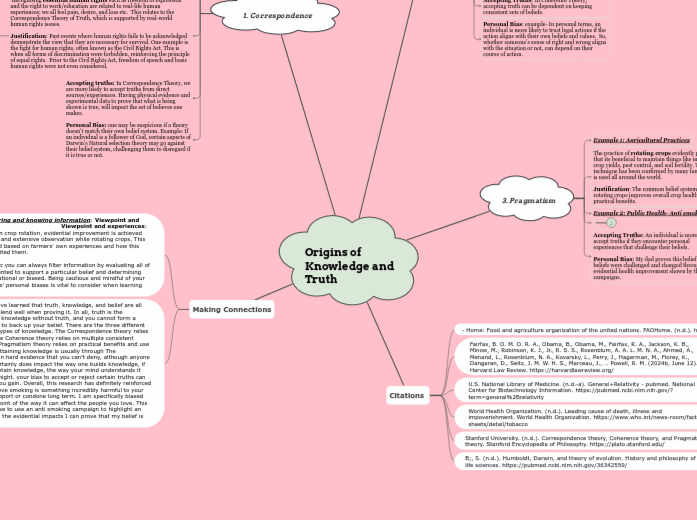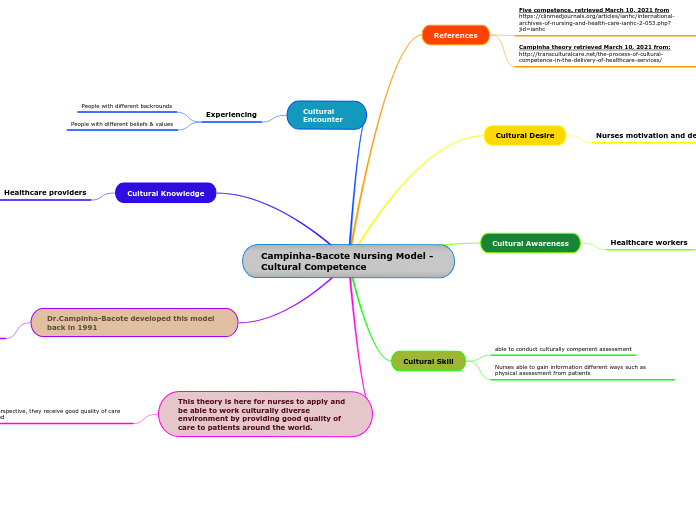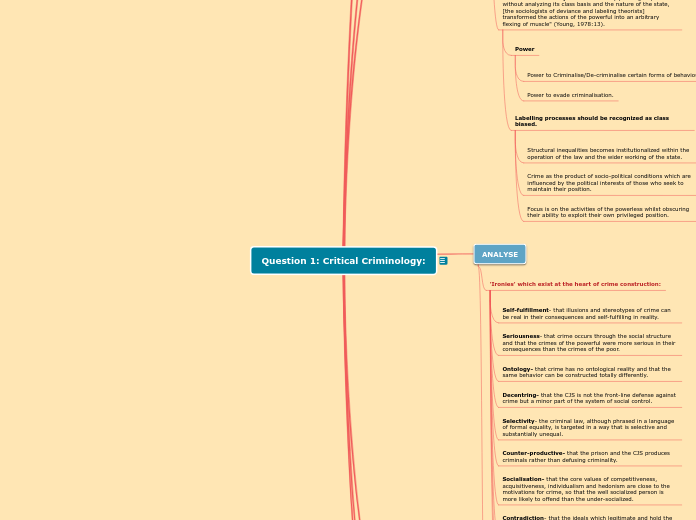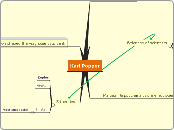Origins of Knowledge and Truth
This template is designed to help you with studying for an exam or qualification. The ideas behind it are described in this article together with tips and suggestions for study techniques.
Begin by typing in the name of the subject that you are studying.
Making Connections
Summary: Throughout this assignment, I've learned that truth, knowledge, and belief are all separate tools to obtaining evidence, but blend well when proving it. In all, truth is the foundation of the three, you cannot obtain knowledge without truth, and you cannot form a belief system without obtaining knowledge to back up your belief. There are the three different theories of truth that can justify different types of knowledge. The Correspondence theory relies on experimental and physical evidence, The Coherence theory relies on multiple consistent confirmations of a belief system, and The Pragmatism theory relies on practical benefits and use of the belief. The more preferable way of attaining knowledge is usually through The Correspondence theory. Its easier to rely on hard evidence that you can't deny, although anyone can have their own belief. Personal bias certainly does impact the way one builds knowledge, if you have specific needs for the way you obtain knowledge, the way your mind understands it may be different then how someone else might. your bias to accept or reject certain truths can affect how much or how little knowledge you gain. Overall, this research has definitely reinforced my own belief system. For example, I believe smoking is something incredibly harmful to your body and its not something I choose to support or condone long term. I am specifically biased because of my own experiences and viewpoint of the way it can affect the people you love. This bias is shown in my assignment, as I choose to use an anti smoking campaign to highlight an example. By understanding and evaluating the evidential impacts I can prove that my belief is justifiable.
Ways of filtering and knowing information: Viewpoint and experiences: Viewpoint and experiences: For example, in crop rotation, evidential improvement is achieved through direct and extensive observation while rotating crops. This can be justified based on farmers' own experiences and how this strategy benefited them.
Cautiousness: you can always filter information by evaluating all of the facts presented to support a particular belief and determining whether it is rational or biased. Being cautious and mindful of your own and others' personal biases is vital to consider when learning knowledge.
1. Correspondence
Map out what you already know about this subject. This will help you to connect new learning with previous knowledge.
Personal Bias: one may be suspicious if a theory doesn't match their own belief system. Example: If an individual is a follower of God, certain aspects of Darwin's Natural selection theory may go against their belief system, challenging them to disregard if it is true or not.
Accepting truths: In Correspondence Theory, we are more likely to accept truths from direct sources/experiences. Having physical evidence and experimental data to prove that what is being shown is true, will impact the set of believes one makes.
Recognising essential human rights such as freedom of expression and the right to work/education are related to real-life human experiences; we all feel pain, desire, and loss etc. This relates to the Correspondence Theory of Truth, which is supported by real-world human rights issues.
Justification: Past events where human rights fails to be acknowledged demonstrate the view that they are necessary for survival. One example is the fight for human rights, often known as the Civil Rights Act. This is when all forms of discrimination were forbidden, reinforcing the principle of equal rights. Prior to the Civil Rights Act, freedom of speech and basic human rights were not even considered.
Connections:Through universal conditions regarding the fight for human rights, it is evident that it was not just erratic and rondom, but are significantly planted in the real shared experiences of humankind.
Example 2: Human Rights
Charles Darwin suggested Natural Selection, a method for evolution in which heritable characteristics that help in organism survival and reproduction become more common in populations over time. This theory is supported by comparative anatomy, genetic evidence, and palaeontology. This is related to the Correspondence Theory of Truth, as natural selection corresponds to his Darwin's descriptions of real-life events and extensive study.
Justification: This belief system that Charles Darwin’s mechanism can be considered a reason for diversity in life can be backed with consistent evidence and experimental data that aligns with the theory. We can see how the most heritable traits are commonized in the real world. For example, the ability to adapt to milk consumption in humans, via persistence of lactase.
Connection: Evidence to justify this is shown in the clear evolutionary changes overtime and genetic similarities among species, all through Natural Selection.
Example 1: The Theory Of Evolution
Citations
B;, S. (n.d.). Humboldt, Darwin, and theory of evolution. History and philosophy of the life sciences. https://pubmed.ncbi.nlm.nih.gov/36342559/
Stanford University. (n.d.). Correspondence theory, Coherence theory, and Pragmatic theory. Stanford Encyclopedia of Philosophy. https://plato.stanford.edu/
World Health Organization. (n.d.). Leading cause of death, illness and impoverishment. World Health Organization. https://www.who.int/news-room/fact-sheets/detail/tobacco
U.S. National Library of Medicine. (n.d.-a). General+Relativity - pubmed. National Center for Biotechnology Information. https://pubmed.ncbi.nlm.nih.gov/?term=general%2Brelativity
Fairfax, B. O. M. O. R. A., Obama, B., Obama, M., Fairfax, R. A., Jackson, K. B., Minow, M., Robinson, K. J., Jr., R. S. S., Rosenblum, A. A. L. M. N. A., Ahmed, A., Menand, L., Rosenblum, N. A., Kovarsky, L., Perry, J., Hagerman, M., Florey, K., Dangaran, D., Seitz, J. M. W. H. S., Marceau, J., … Powell, R. M. (2024b, June 12). Harvard Law Review. https://harvardlawreview.org/
- Home: Food and agriculture organization of the united nations. FAOHome. (n.d.). https://www.fao.org/home/en
3. Pragmatism
Add resources that will help your studies in the topics below.
Accepting Truths: An individual is more likely to accept truths if they encounter personal experiences that challenge their beliefs.
Personal Bias: My dad proves this belief as his beliefs were challenged and changed through evidential health improvement shown by these campaigns.
Try to find previous test papers, and read them early to understand how the syllabus is interpreted.
Example 2: Public Health- Anti smoking campaigns
What opportunities might exist for you to share your knowledge with others?
The practice of rotating crops evidently proves that its beneficial to maintain things like improving crop yields, pest control, and soil fertility. This technique has been confirmed by many famers and is used all around the world.
Justification: The common belief system that rotating crops improves overall crop health practical benefits.
What other research might be helpful? Are there related subjects that would help with your studies of this one?
Connection: Evidence of improvement rates from Crop Rotation can be found in real world statistics on sites like Food and Agriculture Organization (FAO).
Example 1: Agricultural Practices
If you have been given a reading list, map it out below, and add any other relevant publications such as professional journals, published papers, conference proceedings, webinars, and other books.
2. Coherence
The 'dashboard' topic holds useful information to help organise your studies. It is separate from the notes themselves.
Personal Bias: example- In personal terms, an individual is more likely to trust legal actions if the action aligns with their own beliefs and values. So, whether someone's sense of right and wrong aligns with the situation or not, can depend on their course of action.
Accepting Truths: In Coherence Theory, accepting truth can be dependent on keeping consistent sets of beliefs.
Albert Einstein proposes the idea of General Relativity, which means that for all non-accelerating observers all physics are the same. His theory has been believed to be relevant because other scientific explanations align with his theory. Justification: The belief that General Relativity can be justified and can cohere with the laws of physics, are shown through its constant validations in its predictions. An example of this are discovering the ability to bend light using gravity.
What are the deadlines for your studies? Add information about exam dates, new projects to start or changes to make.
Connection: Einsteins General Reletivity Theory can be backed up throught Newtonian mechanincs aligning with its three physical laws.
Example 2: Scientific Theories- General Relativity
What are your purposes for this study? What will you be able to do when it is completed successfully?
The notions of justice and fairness are consistent with the legal system. For example, the phrase "Innocent until proven guilty" can be justified using good legal reasoning. This fosters the idea of fairness in the justice system.
Justification: The principals of the practice demonstrate the conviction that the judicial system fosters fair and unbiased legal practice.
Map out the syllabus for this subject in the tree below. If you have not received a syllabus, make sure you get a copy.
Connections: Fair legal practice in real-world situations can be demonstrated utilising direct sources from Harvard Law, such legal papers and journals, to support the consistent and unbiased workload.
Example 1: Justice System
What are your goals in studying this subject? Are you aiming to pass an exam or gain a qualification? Write it down with target grades if they are important to you.









